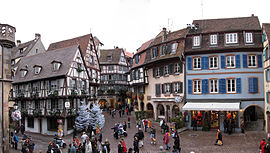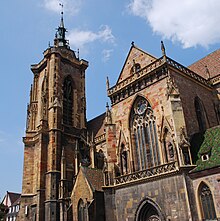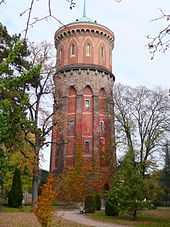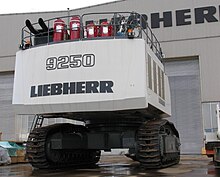| Revision as of 18:02, 29 August 2012 editJYBot (talk | contribs)Extended confirmed users42,944 editsm r2.7.1) (Robot: Adding mzn:کولمر← Previous edit | Revision as of 05:39, 6 September 2012 edit undoJohn (talk | contribs)Extended confirmed users, Rollbackers215,646 edits →Twin towns — Sister cities: MOSICONNext edit → | ||
| Line 206: | Line 206: | ||
| {{See also|List of twin towns and sister cities in France}} | {{See also|List of twin towns and sister cities in France}} | ||
| ===Twin towns — |
===Twin towns — sister cities=== | ||
| Colmar is ] with: | Colmar is ] with: | ||
| {| class="wikitable" | {| class="wikitable" | ||
| |- valign="top" | |- valign="top" | ||
| | | | | ||
| * |
*], United Kingdom | ||
| * |
*], United Kingdom | ||
| * |
*], Austria | ||
| * |
*], Hungary | ||
| || | || | ||
| * |
*], Italy | ||
| * |
*], United States | ||
| * |
*], Germany | ||
| * |
*], Belgium | ||
| |} | |} | ||
Revision as of 05:39, 6 September 2012
| This article needs additional citations for verification. Please help improve this article by adding citations to reliable sources. Unsourced material may be challenged and removed. Find sources: "Colmar" – news · newspapers · books · scholar · JSTOR (June 2012) (Learn how and when to remove this message) |
Place in Grand Est, France
| Colmar Colmar | |
|---|---|
 Old town Old town | |
| Location of Colmar | |
| Country | France |
| Region | Grand Est |
| Department | Haut-Rhin |
| Arrondissement | Colmar |
| Intercommunality | Communauté d'agglomération de Colmar |
| Government | |
| • Mayor (2008–2014) | Gilbert Meyer |
| Area | 66.57 km (25.70 sq mi) |
| Population | 65,713 |
| • Density | 990/km (2,600/sq mi) |
| Time zone | UTC+01:00 (CET) |
| • Summer (DST) | UTC+02:00 (CEST) |
| INSEE/Postal code | 68066 /68000 |
| Dialling codes | 0389 |
| Elevation | 175–214 m (574–702 ft) (avg. 197 m or 646 ft) |
| French Land Register data, which excludes lakes, ponds, glaciers > 1 km (0.386 sq mi or 247 acres) and river estuaries. | |
Colmar (Template:Lang-fr, Template:IPA-fr; Alsatian: Colmer Template:IPA-gsw; German between 1871–1918 and 1940–1945: Kolmar) is a commune in the Haut-Rhin department in Alsace in north-eastern France.
It is the capital of the department. Colmar is also the seat of the highest jurisdiction in Alsace, the appellate court.
It is situated along the Alsatian Wine Route and considers itself to be the "Capital of Alsatian Wine" (capitale des vins d'Alsace).
In 2006, the city of Colmar had a population of 65,713 and the metropolitan area of Colmar had a population of 120,367. Colmar is the center of the arrondissement of Colmar, which has 144,700 inhabitants in 2006.
Colmar is the home town of the painter and engraver Martin Schongauer and the sculptor Frédéric Bartholdi, who designed the Statue of Liberty. The city is renowned for its well preserved old town, its numerous architectural landmarks and its museums, among which is the Unterlinden Museum.
History
Colmar was founded in the 9th century. This was the location where Charles the Fat held a diet in 884. Colmar was granted the status of a free imperial city of the Holy Roman Empire in 1226. In 1575, the city adopted the Protestant Reformation, long after the northern neighbours of Strasbourg and Sélestat. During the Thirty Years' War, the city was taken by the armies of Sweden in 1632, who held it for two years. The city was conquered by France under Louis XIV in 1673.
In 1679 (Treaties of Nijmegen) Colmar was ceded to France. With the rest of Alsace, Colmar was annexed by the newly formed German Empire in 1871 as a result of the Franco-Prussian War. It returned to France after World War I, was annexed by Nazi Germany in 1940, and then reverted to French control after the battle of the "Colmar Pocket" in 1945. Colmar has been continuously governed by conservative parties since 1947, the Popular Republican Movement (1947–1977), the Union for French Democracy (1977–1995) and the Union for a Popular Movement (since 1995), and has had only three mayors during that time.
The Colmar Treasure, hidden during the Black Death, was discovered here in 1863.
Geography

Colmar is 64 kilometres (40 mi) south-southwest of Strasbourg, at 48.08°N, 7.36°E, on the Lauch River, directly to the east of the Vosges Mountains. It is connected to the Rhine by a canal.
Climate
Colmar has a sunny microclimate and is the second driest city in France, with an annual precipitation of just 550 mm, making it ideal for Alsace wine. It is considered the capital of the Alsatian wine region.
| Climate data for Colmar | |||||||||||||
|---|---|---|---|---|---|---|---|---|---|---|---|---|---|
| Month | Jan | Feb | Mar | Apr | May | Jun | Jul | Aug | Sep | Oct | Nov | Dec | Year |
| Mean daily maximum °C (°F) | 4 (39) |
6 (43) |
12 (54) |
15 (59) |
20 (68) |
23 (73) |
26 (79) |
26 (79) |
21 (70) |
16 (61) |
8 (46) |
6 (43) |
15 (60) |
| Mean daily minimum °C (°F) | −1 (30) |
−1 (30) |
2 (36) |
5 (41) |
9 (48) |
12 (54) |
14 (57) |
14 (57) |
10 (50) |
7 (45) |
2 (36) |
1 (34) |
6 (43) |
| Average precipitation mm (inches) | 25.5 (1.00) |
18.9 (0.74) |
22.5 (0.89) |
29.4 (1.16) |
42.7 (1.68) |
39.6 (1.56) |
45.1 (1.78) |
34.4 (1.35) |
38.5 (1.52) |
43.2 (1.70) |
29.7 (1.17) |
25.0 (0.98) |
394.5 (15.53) |
| Source: | |||||||||||||
The dryness results from the town's location next to mountains which force clouds arriving from the west to rise, and much of their moisture to condense and fall as precipitation over the higher ground, leaving the air warmed and dried by the time it reaches Colmar.
Main sights
Mostly spared from the destructions of the French Revolution and the wars of 1870–1871, 1914–1918 and 1939–1945, the cityscape of old-town Colmar is homogenous and renowned among tourists. An area that is crossed by canals of the river Lauch (which formerly served as the butcher's, tanner's and fishmonger's quarter) is now called "little Venice" (la Petite Venise). Colmar's cityscape (and neighbouring Riquewihr's) served for the design of the Japanese animated film Howl's Moving Castle.
Architectural landmarks






Colmar's secular and religious architectural landmarks reflect eight centuries of Germanic and French architecture and the adaptation of their respective stylistic language to the local customs and building materials (pink and yellow Vosges sandstone, timber framing).
Secular buildings
- Maison Adolph – 14th century (German Gothic)
- Koifhus, also known as Ancienne Douane – 1480 (German Gothic)
- Maison Pfister – 1537 (German Renaissance).
- Ancien Corps de garde – 1575 (German Renaissance)
- Maison des Chevaliers de Saint-Jean – 1608 (German Renaissance)
- Maison des Têtes – 1609 (German Renaissance)
- Poêle des laboureurs – 1626 (German Baroque)
- Ancien Hôpital – 1736–1744 (French Classicism)
- Tribunal de grande instance – 1771 (French Classicism)
- Hôtel de ville – 1790 (French Classicism)
- Cour d'Assises – 1840 (French Neoclassicism)
- Théâtre municipal – 1849 (French Neoclassicism)
- Marché couvert – 1865 (French Neo-Baroque). The city's covered market, built in stone, bricks and cast iron, still serves today.
- Préfecture – 1866 (French Neo-Baroque)
- Water tower – 1886. Oldest still preserved water tower in Alsace. Out of use since 1984.
- Gare SNCF – 1905 (German Neo-Baroque)
- Cour d'appel – 1906 (German Neo-Baroque)
Religious buildings
- Église Saint-Martin – 1234–1365. The largest church of Colmar and one of the largest in Haut-Rhin. Displays some early stained glass windows, several Gothic and Renaissance sculptures and altars, a grand Baroque organ case. The choir is surrounded by an ambulatory opening on a series of Gothic chapels, a unique feature in Alsacian churches.
- Église des Dominicains – 1289–1364. Now disaffected as a church, displays Martin Schongauer's masterwork La Vierge au buisson de roses as well as 14th century stained glass windows and baroque choir stalls. The adjacent convent buildings house a section of the municipal library.
- Église Saint-Matthieu – 13th century. Gothic and Renaissance stained glass windows and mural paintings, as well as a wooden and painted ceiling.
- Couvent des Antonins – 13th century. Disaffected church and convent buildings notable for a richly ornate cloister. Now housing the Unterlinden Museum (see below).
- Église Sainte-Catherine – 1371. Disaffected church and convent buildings now used as an assembly hall and festival venue (Salle des Catherinettes).
- Chapelle Saint-Pierre – 1742–1750. Classicist chapel of a former Jesuit college.
- Synagogue – 1843 (Neoclassicism)
Fountains
- Fontaine de l'Amiral Bruat – 1864 (Statue by Bartholdi)
- Fontaine Roeselmann – 1888 (Statue by Bartholdi)
- Fontaine Schwendi – 1898 (Statue by Bartholdi)
Monuments
- Monument du Général Rapp – 1856 (first shown 1855 in Paris. Statue by Bartholdi, his earliest major work)
- Monument Hirn – 1894 (Statue by Bartholdi)
- Statue "Les grands soutiens du monde" − 1902 (in the courtyard of the Bartholdi Museum)
- Statue of Liberty replica
Museums
- Unterlinden Museum – one of the main museums in Alsace. Displays the Isenheim Altarpiece, a large collection of medieval, Renaissance and baroque Upper-Rhenish paintings and sculptures, archaeological artefacts, design and international modern art.
- Musée Bartholdi – the birthplace of Frédéric Bartholdi shows his life and work through paintings, drawings, family objects and furniture as well as numerous plaster, metal and stone sculptures. A section of the museum is further dedicated to the local Jewish community's heritage.
- Musée d'histoire naturelle et d'ethnographie – the zoological and ethnographic museum of Colmar was founded in 1859. Besides a large collection of stuffed animals and artefacts from former French and German colonies in Africa and Polynesia, it also houses a collection of ancient Egyptian items.
- Musée du jouet – the town's toy museum, founded 1993
- Musée des usines municipales – industrial and technological museum in a former factory, dedicated to the history of everyday technology.
Library
The Municipal Library of Colmar (Bibliothèque municipale de Colmar) owns one of the richest collections of incunabula in France, with more than 2,300 volumes. This is quite an exceptional number for a city that is neither the main seat of a university, nor of a college, and has its explanation in the disowning of local monasteries, abbeys and convents during the French Revolution and the subsequent gift of their collections to the town.
Transport
The small regional Colmar Airport serves Colmar.
The train station Gare de Colmar offers connections to Strasbourg, Mulhouse, Besançon, Zürich and several regional destinations. Colmar was also once linked to Freiburg im Breisgau, in Germany and on the other side of the Rhine, by the Freiburg–Colmar international railway. However the railway bridge over the Rhine between Breisach and Neuf-Brisach was destroyed in 1945 and never replaced.
Education
Colmar shares the Université de Haute-Alsace with the neighbouring, larger city of Mulhouse. Of the approximately 8,000 students of the UHA, circa 1,500 study at the Institut universitaire de technologie (IUT) Colmar, at the Colmar branch of the Faculté des Sciences et Techniques and at the Unité de Formation et de Recherche Pluridisciplinaire d'Enseignement Professionalisé Supérieur (UFR P.E.P.S.).
Music
Since 1980, Colmar is home to the international summer festival of classical music Festival de Colmar (also known as Festival international de musique classique de Colmar). In its first version (1980 to 1989), it was placed under the artistic direction of the German conductor Karl Münchinger. Since 1989, it is helmed by the Russian violinist and conductor Vladimir Spivakov.
Economy



Colmar is an affluent city whose primary economic strength lies in the flourishing tourist industry. But it is also the seat of several large companies: Timken (European seat), Liebherr (French seat), Leitz (French seat), Capsugel France (A division of Pfizer) ...
Every year since 1947, Colmar is host to what is now considered as the biggest annual commercial event as well as the largest festival in Alsace, the Foire aux vins d'Alsace (Alsacian wine fair).
When Air Alsace existed, its head office was on the grounds of Colmar Airport.
Notable people
The following people were born in Colmar:
- Martin Schongauer (1450–1491), painter and engraver
- Georg Wickram (1502–1562), poet and novelist
- Antoine Xavier Natal (1733–1801), brigadier during the French Revolution
- Jean-François Rewbell (1747–1807), diplomat and revolutionist
- Jean Rapp (1771–1821), general
- Charles Xavier Thomas (1785–1870), inventor
- Marie Bigot (1786–1820), musician
- Armand Joseph Bruat (1796–1855), admiral
- Georges-Charles de Heeckeren d'Anthès (1812–1895), politician, killer of Alexander Pushkin in a duel
- Frédéric Auguste Bartholdi (1834–1904), sculptor, created the original Statue of Liberty
- Camille Sée, (1847–1919), politician
- Jean-Baptiste Lemire (1867–1945), composer
- Jean-Jacques Waltz (1873–1951), drawer and caricaturist
- Guy Roux (born 1938), football coach
- Pierre Moerlen (1952–2005), musician
- Pierre Hermé (born 1961), pastry chef
- Thomas Bloch (born 1962), musician
- Lætitia Bléger (born 1981), Miss France 2004
- Marc Keller (born 1968), football player
- Amaury Bischoff (born 1987), football player
International relations
See also: List of twin towns and sister cities in FranceTwin towns — sister cities
Colmar is twinned with:
|
|
See also
References
- Commune : Colmar (68066) on INSEE
- Aire urbaine 1999 : Colmar (067) on INSEE
- Arrondissement : Colmar (682) on INSEE
- Template:En icon "Données climatologiques de Colmar".
- http://www.colmar.fr/culture/bibliotheque-centrale.html
- History of the Wine fair Template:Fr icon
- "World Airline Directory." Flight International. 13 February 1975. 247.
External links
- Template:Wikitravel
- Official website of the city of Colmar
- Wine domain of the city of Colmar
- Tourist office of Colmar
- Colmar Music Festival
| |